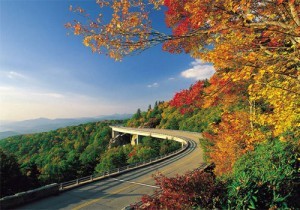Shenandoah National Park - Skyline Drive
Introduction
Text-to-speech Audio
Images
View of the Blue Ridge Mountains for Skyline Drive.

Map of Skyline Drive.

View of Skyline Drive while driving.

Backstory and Context
Text-to-speech Audio
Shenandoah National Park’s Skyline Drive is a 105 mile road that winds north-south through Virginia’s Blue Ridge Mountains, from Front Royal to Charlottesville. Before Skyline Drive was built in the 1930s, settlers who made their homes in the mountains used narrow, rocky mountain trails to haul supplies and materials into the mountains via wagons and mules. When George Freeman Pollock visited one of his failed copper mines in the late 1890s, he decided to build a mountain resort near Stony Man Mountain, and Skyland Resort soon became a reality.
While not a successful miner or businessman, Pollock was a successful showman. His new resort drew in wealthy families who sought to escape the heat of Washington, D.C.’s summers, and he rewarded them with fancy bonfires, pageants, balls, and parties. Initially, Skyland’s visitors stayed for months at a time, as access to the resort required trekking up dangerous, unpaved mountain roads. But as automobiles became more common and roads to the park became more accessible, many visitors began making shorter stays of a few weeks and ultimately to a few days.
Construction of Skyline
Drive began in 1931. The initial stretch of the Drive, from Thornton Gap to Swift
Run Gap, passed adjacent to Skyland Resort, which became a concessionaire of the park. In
1933, during the Great Depression, President Franklin Roosevelt created the
Civilian Conservation Corps, an agency that provided jobs to young, single,
able-bodied men. They performed hard manual labor building roads, bridges,
dams, parks, and other public works projects, including re-grading Skyline
Drive, planting trees and shrubs (including the popular mountain laurel), fixing drainage, and building low walls and overlooks along the Drive
to prevent erosion and to prevent falls.
Hundreds of thousands of visitors travel the Drive each year, with peak visitation during the changing leaves in the autumn. During this time, bears, filling up on nuts and berries for the winter, are a common sight in the trees. In the summer months, visitors can hike, relax at Skyland Resort, take a leisurely drive along Skyline Drive, camp, go horseback riding, see some of the park's many waterfalls, attend many Ranger-led hikes and programs, check out the interactive exhibits at the Byrd Visitor Center at Big Meadows (Mile 51 along Skyline Drive), and visit many of the park's historic buildings. In the winter months, visitors can go backcountry camping, snowshoeing, and hiking to see frozen waterfalls. Skyline Drive is open year-round, so visitors can enjoy the scenery and the trip in any weather.
Sources
National Geographic, Shenandoah National Park, https://www.nationalgeographic.com/travel/national-parks/shenandoah-national-park/. Accessed 27 Aug 2018.
